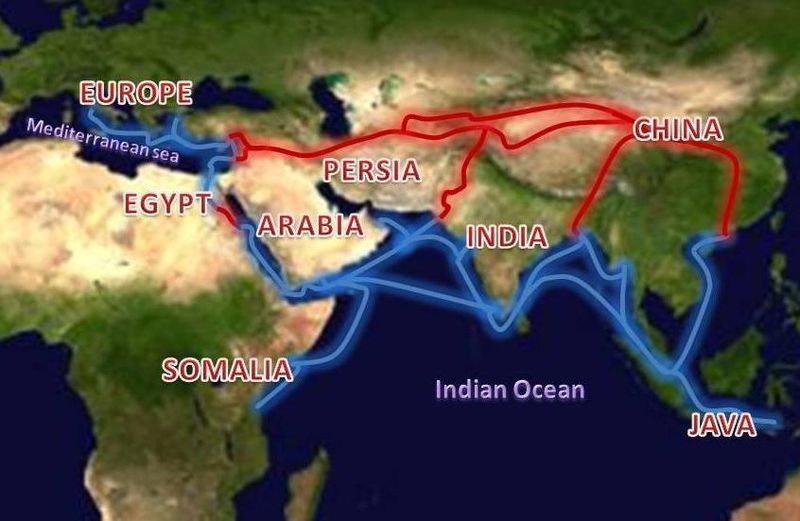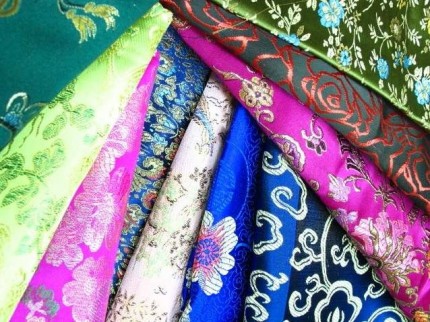The Silk Road

The name 'Silk Road' conjures up images of caravans, Lawrence of Arabia and exotic locals. This is the famed route that Marco Polo took when he brought back, the 'wonders' of the Orient. The term Silk Road was coined in 1870 by German geographer Ferdinand van Richthofen, the uncle of the famed Red Baron.
Most have a common misconception that The Silk Road was one long route, but as you can see by the map to the right, it was actually a series of many routes, which changed constantly between the land and sea between China, the Middle East, the Mediterranean, and Europe. All started from the capital in Changan, headed up the Gansu corridor, and reached Dunhuang on the edge of the Taklimakan. It connected the Yellow River Valley to the Mediterranean Sea and passed through places such as Chinese cities Kansu and Sinkiang and the present-day countries of Iran, Iraq and Syria.
Silk Road routes were often disrupted due the presence of bandits, political alliances, passes closed by snow, droughts, storms, seasonal changes, wars, plagues, horsemen raids, and natural disasters. Many Silk Road towns and caravanserais were located within fortresses for protection from bandits and marauding horsemen. Many also had security forces.
The term Silk Road can be a bit misleading though, as commodities were also traded, from gold and ivory to exotic animals and plants. Of all the precious goods crossing this area, silk was perhaps the most remarkable for the people of the West, and is likely why the name was given, but many caravans heading towards China carried many commodities included silk, porcelain from  China; pepper, batik, spices, perfumes, glass beads, gems and muslin from India; incense, cinnamon, cloves and nutmeg from the East Indies, diamonds from Colcond; nuts, sesame seeds, glass and carpets from Persia; as well as coral and ivory from Siam. Other goods that made their way west included furs, ceramics, medicinal rhubarb, peaches, pomegranates, and gunpowder. In cold areas, flint and steel were among the most sought after products.
China; pepper, batik, spices, perfumes, glass beads, gems and muslin from India; incense, cinnamon, cloves and nutmeg from the East Indies, diamonds from Colcond; nuts, sesame seeds, glass and carpets from Persia; as well as coral and ivory from Siam. Other goods that made their way west included furs, ceramics, medicinal rhubarb, peaches, pomegranates, and gunpowder. In cold areas, flint and steel were among the most sought after products.
In the opposite direction, coming east, traders brought fine tableware, wool, horses, jade, wine, cucumbers, and walnuts. Ivory, gold, tortoise shells, dugs and slaves and animals such as ostriches and giraffes came from Africa. Frankincense and myrrh were brought from Arabia. Mediterranean colored glass was treasured almost as much in some parts of the East as silk was in the West.
The main reason for the voyages of Christopher Columbus was in search of a new 'Silk Road' to the Orient, so some might argue that the discovery of America is directly related to it.
Spices
 Spices were among the most valuable commodities carried on the Silk Road. Without refrigeration food spoiled easily and spices were important for masking the flavor of rancid or spoiled meat. Basil, mint, sage, rosemary and thyme could be grown in family herb gardens in Europe along with medicinal plants. Among the spices and seasonings that came from the East--affordable to merchants and burghers but not ordinary people--were pepper, cloves, mace and cumin. Ginger, nutmeg, cinnamon and saffron--the most valuable of spices from the East--were worth more than their weight in gold.
Spices were among the most valuable commodities carried on the Silk Road. Without refrigeration food spoiled easily and spices were important for masking the flavor of rancid or spoiled meat. Basil, mint, sage, rosemary and thyme could be grown in family herb gardens in Europe along with medicinal plants. Among the spices and seasonings that came from the East--affordable to merchants and burghers but not ordinary people--were pepper, cloves, mace and cumin. Ginger, nutmeg, cinnamon and saffron--the most valuable of spices from the East--were worth more than their weight in gold.
During the Middle Ages, one medieval town sold 288 kinds of spices, many of whom had an unknown origin. Cinnamon, people were told, came from an exotic bird and cloves were netted in the Nile by Egyptians. Caravans that carried pepper were heavily armed.
Transportation

Bactrian camels were commonly used on the Silk Road to carry goods. They could be employed in high mountains, cold steppes and inhospitable deserts.
Bactrian camels are camels with two humps and two coats of hair. Widely domesticated and capable of carrying 600 pounds, they are native to Central Asia, where a few wild ones still live, and stand six feet at the hump, can weigh half a ton and seem no worse for wear when temperatures drop to -20 degrees F. The fact they can endure extreme hot and cold and travel long periods of time without water has made them ideal  caravan animals.
caravan animals.
Bactrian camels can go a week without water and a month without food. A thirsty camel can drink 25 to 30 gallons of water at one go. For protection against sandstorms, Bactrian camels have two sets of eyelids and eyelashes. The extra eyelids can wipe sand like windshield wipers. Their nostrils can shrink to a narrow slit to keep out blowing sand. Male Bactrian camels slobber a lot when they get horny.
The humps store energy in the form of fat and can reach a height of 18 inches and individually hold as much as 100 pounds. A camel can survive for weeks without food by drawing on the fat from the humps for energy. The humps shrink, go flaccid and droop when a camel doesn't get enough to eat as it loses the fat that keep the humps erect.
 In the larger towns, the larger caravans stayed for a while, resting and fattening up their animals, purchasing new animals, relaxing and selling or trading goods. To meet their needs were banks, exchange houses, trading firms, markets, brothels and places where one could smoke hashish and opium. Some of these caravan stops became rich cities such like Samarkand and Bukhara.
In the larger towns, the larger caravans stayed for a while, resting and fattening up their animals, purchasing new animals, relaxing and selling or trading goods. To meet their needs were banks, exchange houses, trading firms, markets, brothels and places where one could smoke hashish and opium. Some of these caravan stops became rich cities such like Samarkand and Bukhara.
Caravanserai had rooms for caravan members, fodder and resting places for animals and warehouses for storing goods. They were often in small fortresses with guards to protect the caravans from bandits.
A typical caravanserai was a set of buildings surrounding an open courtyard, where the animals were kept. The animals were tied to wooden stakes. The rates for a stopover and fodder depended on  the animal. Caravanserai owners often supplemented their incomes by gathering manure and selling it for fuel and fertilizer. The price for manure was set according to the animal that produced it and how much straw and grass was mixed in. Cow and donkey manure was regarded as high quality because it burned the hottest and kept mosquitos away.
the animal. Caravanserai owners often supplemented their incomes by gathering manure and selling it for fuel and fertilizer. The price for manure was set according to the animal that produced it and how much straw and grass was mixed in. Cow and donkey manure was regarded as high quality because it burned the hottest and kept mosquitos away.
Traders and travelers had problems with local food and foreign languages like modern travelers. They also had to deal with rules prohibiting certain native costumes and get permits to enter city gates, which explained their wants and needs and showed they presented no threat.
Past Features
Sources
www.wikipedia.org, en:Image:Silk Route extant.jpg, www.ess.uci.edu/~oliver/silk.html, New York Times, Washington Post, Los Angeles Times, Times of London, National Geographic, The New Yorker, Time, Newsweek, Reuters, AP, Lonely Planet Guides, Compton’s Encyclopedia , www.siemerhand.com, ,www.sfusd.k12.ca.us, singlemindedwomen.com , www.sandomenico.org ,www.veeriku.tartu.ee, www.ruby-sapphire.com,


